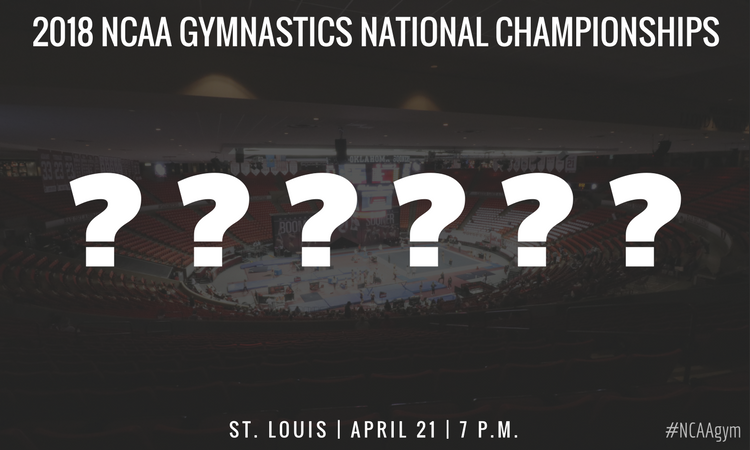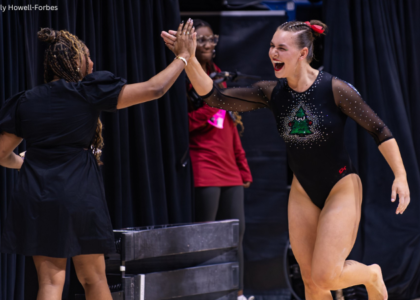The Super Six is nearly impossible to predict. But we tried anyway, taking a look at the likely title contenders and exactly what they need to do to bring home the trophy at the end of the weekend.
| Vault | Bye before Bars | Bars | Beam | Bye before Floor | Floor | |
| Rotation 1 | Semi 2, Team 2 | Semi 1, Team 2 | Semi 1, Team 3 | Semi 2, Team 1 | Semi 1, Team 1 | Semi 2, Team 3 |
| Rotation 2 | Semi 2, Team 3 | Semi 2, Team 2 | Semi 1, Team 2 | Semi 1, Team 3 | Semi 2, Team 1 | Semi 1, Team 1 |
| Rotation 3 | Semi 1, Team 1 | Semi 2, Team 3 | Semi 2, Team 2 | Semi 1, Team 2 | Semi 1, Team 3 | Semi 2, Team 1 |
| Rotation 4 | Semi 2, Team 1 | Semi 1, Team 1 | Semi 2, Team 3 | Semi 2, Team 2 | Semi 1, Team 2 | Semi 1, Team 3 |
| Rotation 5 | Semi 1, Team 3 | Semi 2, Team 1 | Semi 1, Team 1 | Semi 2, Team 3 | Semi 2, Team 2 | Semi 1, Team 2 |
| Rotation 6 | Semi 1, Team 2 | Semi 1, Team 3 | Semi 2, Team 1 | Semi 1, Team 1 | Semi 2, Team 3 | Semi 2, Team 2 |
While it is quite hard to preview the last-ever Super Six without knowing who will qualify for it, a few teams have become serious contenders for the national title throughout the 2018 season. Once again, anything in semifinals is possible as we have witnessed over the years, and we may be in for some upsets. But assuming the favorites make it through, the hunt for the 2018 title will be a close and exciting one.
The obvious favorite is the two-time defending champion and three-time title holder Oklahoma. The Sooners have held the No. 1 ranking for 10 straight weeks during the regular season and hold a NCAA-record RQS of 198.120. With an average of 197.850 and a high score of 198.375—0.283 and 0.200 higher than No. 2 LSU, respectively—the Sooners have a bit of a cushion heading into the Super Six. They scored above 198 eight times this season while their direct competitors have only reached that score eight times total, four from LSU, two from UCLA and one each from Florida and Utah.
Oklahoma is a team that’s well-paced and knows how to perform under pressure, but it has shown this season that it might be slightly more vulnerable than in previous years. Throughout the regular season, the lineups on vault and floor changed frequently, something we are not used to seeing as head coach KJ Kindler typically likes to settle her lineups early on and rarely changes them. The Sooners also had a few off meets on floor, so this event will be crucial for the Sooners to hit if they want to keep the other teams at bay.
The two likely teams to upset the Sooners are LSU and UCLA, which are essentially neck and neck in terms of scoring potential. The Tigers are in the hunt for their very first national title and have exceeded all expectations after graduating the strong class of Ashleigh Gnat, Sydney Ewing and Shae Zamardi and of losing McKenna Kelley to a season-ending injury. Led by Sarah Finnegan and Myia Hambrick, the Tigers have an RQS of 197.890, average 197.587 and have a high score of 198.175. The event to watch for the Tigers will be vault as they have had falls early in the lineup in four of the last five meets, which has turned it into a nerve-wracking event. However, they will need to go all out during Super Six if they hope to beat Oklahoma, and to do so means going for the big vaults.
The Bruins will also be right in the hunt for their seventh NCAA title and first since 2010. Fans can expect a close battle with LSU as UCLA’s highest score is higher than LSU’s, its RQS is only 0.050 behind LSU’s and its average is essentially the same with only a 0.033 difference. The Bruins looked better as the season advanced but still have to work out some kinks. The uneven bars have been the problematic event for them most of the season, especially with a shaky and prone-to-miss first half of the lineup that could make it hard to hang with OU and LSU on their good days. However, UCLA was able to bring in Olympic gold and silver medalist Madison Kocian back into that lineup at regionals, which provided a nice boost in this lineup, bringing it closer to the likes of the Sooners and Tigers. Vault is another event for the Bruins that could shape up to be tricky as this lineup lacks the 10.0 vaults (only two Yurchenko 1.5s from Pua Hall and Felicia Hano) it needs if it comes down to the wire with OU and LSU for the title. With these easier vaults, the Bruins absolutely have to nail their landings to make up for the difference in start value.
Assuming they make it out of their semifinals, Utah and Florida should also be in the conversation for the title albeit with a longer shot than the three teams mentioned previously. The Utes were fairly consistent all season and managed to only have 10 missed routines in all of 2018. They are quite close to Florida in terms of RQS and average, and both teams have the same season-high score of 198.150. There are still a few questions marks for Utah on bars and beam, still with the potential for falls. The Utes have only hit the 198 mark once and are mostly a mid-197 team, so it will take the other teams to be off for Utah to sneak in for the win.
The Gators started the season as the favorites with a roster stacked with talent and no loss of postseason routines from a year ago, but injuries and struggles to regularly hit a complete meet made it harder to consider them an obvious contender. The Gators appeared more fragile since they lost senior Kennedy Baker to a career-ending injury and struggled with consistency all season long. Florida had a lot of missed meets where it counted falls, especially on beam and floor. Much like Utah, it will take bad days from the top three teams and a great day from Florida for it to be in the race for the title.
Want to receive the latest collegiate gymnastics news in your inbox? Sign up for the NCAA Gym NewsLetter here.
Article by Christina Marmet




